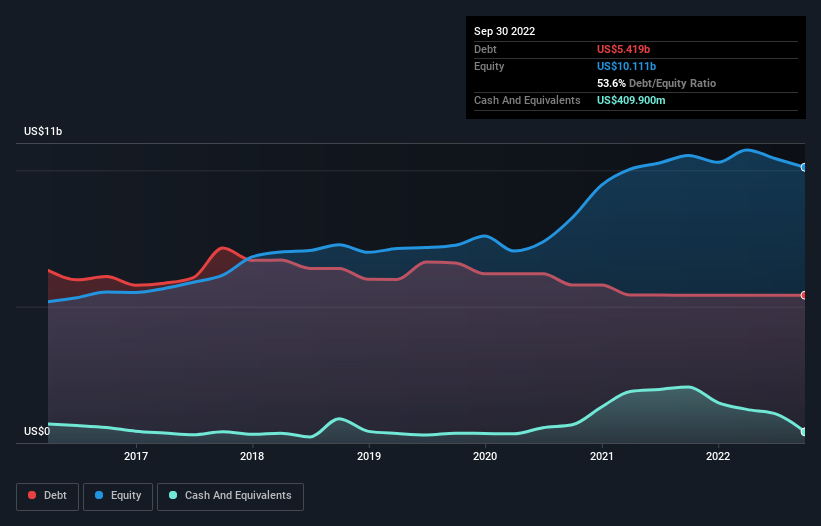Stock Analysis
- United States
- /
- Healthcare Services
- /
- NYSE:LH
Here's Why Laboratory Corporation of America Holdings (NYSE:LH) Can Manage Its Debt Responsibly

The external fund manager backed by Berkshire Hathaway's Charlie Munger, Li Lu, makes no bones about it when he says 'The biggest investment risk is not the volatility of prices, but whether you will suffer a permanent loss of capital.' It's only natural to consider a company's balance sheet when you examine how risky it is, since debt is often involved when a business collapses. We note that Laboratory Corporation of America Holdings (NYSE:LH) does have debt on its balance sheet. But the real question is whether this debt is making the company risky.
Why Does Debt Bring Risk?
Generally speaking, debt only becomes a real problem when a company can't easily pay it off, either by raising capital or with its own cash flow. Part and parcel of capitalism is the process of 'creative destruction' where failed businesses are mercilessly liquidated by their bankers. While that is not too common, we often do see indebted companies permanently diluting shareholders because lenders force them to raise capital at a distressed price. Of course, debt can be an important tool in businesses, particularly capital heavy businesses. When we examine debt levels, we first consider both cash and debt levels, together.
View our latest analysis for Laboratory Corporation of America Holdings
How Much Debt Does Laboratory Corporation of America Holdings Carry?
The chart below, which you can click on for greater detail, shows that Laboratory Corporation of America Holdings had US$5.42b in debt in September 2022; about the same as the year before. On the flip side, it has US$409.9m in cash leading to net debt of about US$5.01b.

A Look At Laboratory Corporation of America Holdings' Liabilities
According to the last reported balance sheet, Laboratory Corporation of America Holdings had liabilities of US$2.52b due within 12 months, and liabilities of US$7.19b due beyond 12 months. On the other hand, it had cash of US$409.9m and US$2.98b worth of receivables due within a year. So its liabilities total US$6.32b more than the combination of its cash and short-term receivables.
While this might seem like a lot, it is not so bad since Laboratory Corporation of America Holdings has a huge market capitalization of US$22.3b, and so it could probably strengthen its balance sheet by raising capital if it needed to. But we definitely want to keep our eyes open to indications that its debt is bringing too much risk.
We measure a company's debt load relative to its earnings power by looking at its net debt divided by its earnings before interest, tax, depreciation, and amortization (EBITDA) and by calculating how easily its earnings before interest and tax (EBIT) cover its interest expense (interest cover). The advantage of this approach is that we take into account both the absolute quantum of debt (with net debt to EBITDA) and the actual interest expenses associated with that debt (with its interest cover ratio).
Laboratory Corporation of America Holdings's net debt to EBITDA ratio of about 1.6 suggests only moderate use of debt. And its strong interest cover of 15.7 times, makes us even more comfortable. In fact Laboratory Corporation of America Holdings's saving grace is its low debt levels, because its EBIT has tanked 35% in the last twelve months. Falling earnings (if the trend continues) could eventually make even modest debt quite risky. The balance sheet is clearly the area to focus on when you are analysing debt. But it is future earnings, more than anything, that will determine Laboratory Corporation of America Holdings's ability to maintain a healthy balance sheet going forward. So if you're focused on the future you can check out this free report showing analyst profit forecasts.
Finally, a company can only pay off debt with cold hard cash, not accounting profits. So we always check how much of that EBIT is translated into free cash flow. Over the most recent three years, Laboratory Corporation of America Holdings recorded free cash flow worth 67% of its EBIT, which is around normal, given free cash flow excludes interest and tax. This cold hard cash means it can reduce its debt when it wants to.
Our View
Based on what we've seen Laboratory Corporation of America Holdings is not finding it easy, given its EBIT growth rate, but the other factors we considered give us cause to be optimistic. There's no doubt that its ability to to cover its interest expense with its EBIT is pretty flash. It's also worth noting that Laboratory Corporation of America Holdings is in the Healthcare industry, which is often considered to be quite defensive. Considering this range of data points, we think Laboratory Corporation of America Holdings is in a good position to manage its debt levels. But a word of caution: we think debt levels are high enough to justify ongoing monitoring. The balance sheet is clearly the area to focus on when you are analysing debt. However, not all investment risk resides within the balance sheet - far from it. For example, we've discovered 3 warning signs for Laboratory Corporation of America Holdings (1 is a bit concerning!) that you should be aware of before investing here.
Of course, if you're the type of investor who prefers buying stocks without the burden of debt, then don't hesitate to discover our exclusive list of net cash growth stocks, today.
Valuation is complex, but we're helping make it simple.
Find out whether Labcorp Holdings is potentially over or undervalued by checking out our comprehensive analysis, which includes fair value estimates, risks and warnings, dividends, insider transactions and financial health.
View the Free AnalysisHave feedback on this article? Concerned about the content? Get in touch with us directly. Alternatively, email editorial-team (at) simplywallst.com.
This article by Simply Wall St is general in nature. We provide commentary based on historical data and analyst forecasts only using an unbiased methodology and our articles are not intended to be financial advice. It does not constitute a recommendation to buy or sell any stock, and does not take account of your objectives, or your financial situation. We aim to bring you long-term focused analysis driven by fundamental data. Note that our analysis may not factor in the latest price-sensitive company announcements or qualitative material. Simply Wall St has no position in any stocks mentioned.
About NYSE:LH
Labcorp Holdings
Operates as a laboratory services company that provides vital information to help doctors, hospitals, pharmaceutical companies, researchers, and patients make clear and confident decisions.
Mediocre balance sheet and slightly overvalued.

